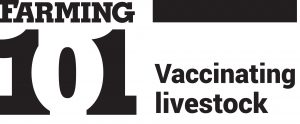To protect your livestock against infectious diseases, it is important to vaccinate at the right time with the right product. Proper handling of the vaccination from purchase to administration will ensure the vaccine’s effectiveness.
1Purchasing and storing
Purchase vaccines from a reputable source that will deliver a high-quality product. Most vaccines should be refrigerated — heat can make vaccines ineffective, so don’t let them heat up to room temperature. Freezing can also cause the vaccine to become ineffective.
Check the recommended storage temperature and use a cooler while transporting.
2Types of vaccines
Generally, there are two types of vaccines: modified live and killed. Modified live vaccines are treated so the disease virus will not cause the disease, but will allow the animal to develop immunity to the disease. The virus reproduces inside the animal and the animal’s immune system builds up antibodies. Modified live vaccines are not safe for pregnant animals because the vaccine mimics an infection.
Killed vaccines are made from viruses or bacteria that are no longer active. These vaccines stimulate the animal’s production of antibodies to defend against the disease — these are safe to give to pregnant animals.
3Handling
If a vaccine requires mixing, use the rehydrating solution packaged with the vaccine. Only prepare what you need for the number of animals you will be vaccinating and discard any leftovers. The vaccine will lose its effectiveness as quickly as one to two hours after mixing, so it’s important to mix only what you will need.
Make sure equipment is clean and set up a work area that is cool, shaded and dust-free while working. Keep vaccines on ice in a cooler in the summer while working. Always use a new needle to draw up the vaccine into the syringe.
4Type of injection
Follow the label for administration directions. Some products call for subcutaneous (SQ) injections, which are given under the skin; others are given in the muscle (IM). If you have a choice, SQ injections are recommended to minimize damage to muscle tissue. Best areas for injections are in the neck or in front of the shoulder.
5Restraint
It is important to keep the animal restrained and as still as possible when administering vaccines. This helps prevent broken needles as well as harm to the animal or the human giving the injection. Needle movement during administration could cause muscle damage or decrease the efficacy of the vaccine.
6Records
Keep good records of animal vaccinations to ensure they are getting effective treatments. Younger animals may require an additional vaccination within a few weeks. Then, annual boosters may be necessary.
If the animal will be used as a meat product, pay attention to withdrawal times. Most are 21 to 28 days after injection.
Sources: Proper handling of livestock vaccines, Penn State Extension; Injection site management, University of Arkansas Extension.
(Farm and Dairy is featuring a series of “101” columns throughout the year to help young and beginning farmers master farm living. From finances to management to machinery repair and animal care, farmers do it all.)
More Farming 101 columns:
- 5 tips to prevent dairy cow foot problems
- 6 common foot problems found in dairy cows
- Recognize, prevent heat stress in dairy cattle
- How to monitor your dairy herd
- How to start your own dairy farm
- 5 tips for sun safety in the field
- Employing youth for the summer
- What to do if a hay fire occurs
- How to prevent hay fires
- How to extend the life of your fence
- 10 safety tips for installing electric fences
- How to chose the right fence for your farm
- How to create a fencing plan
- 7 steps for easy sprayer calibration
- Prepare for planting season, Part 2: Calibration
- Prepare for planting season, Part 1: The Basics
- 7 tips to improve security on your farm
- 5 tips to protect your farmland
- 3 measures to deal with severe farm debt
- How to buy time to catch up on farm debt
- 6 tips to manage income on the farm
- 5 tips to recognize and deal with farm stress
- How to prepare a livestock birthing kit
- 5 tips for marketing your farm
- How to develop farm mission, vision statements
- 5 tips for setting farm goals
- 2 types of livestock insurance policies
- 6 things you need to know about WFRP plans
- 3 basics of crop insurance
- How does liability insurance work on the farm?
- Why do I need farm insurance?
- How to understand and use Ohio’s CAUV
- How to utilize the Pa. Clean and Green Act
- 9 tips for filing farm taxes
- 8 reasons record keeping for taxes is essential
- 5 tips for post-harvest storage
- 7 tips for family meetings on the farm
- 4 tips for balancing your farm and family
- 4 tips for communicating on the family farm
- 4 tips for firing an employee
- 6 tips for keeping good farm help
- 4 tips for recruiting farm labor
- 5 general farm labor laws
- 4 tips for employing minors
- 4 tips for PTO safety
- 5 things young farmers should know about finances
- The farm balance sheet
- 5 items for your farm’s cash flow statement
- Personal and business records: Keep them separate
- What to include in your farm business plan
- How to approach a lender: Tips for getting a farm loan
- How to use microloans to get your farm started
- Saving for the future: 6 tips for young farmers
- How to create a farm safety kit
- 5 tips for child safety on the farm
- 4 tips for transporting livestock
- 5 ways to better understand tractor stability
- 6 farm equipment hacks













